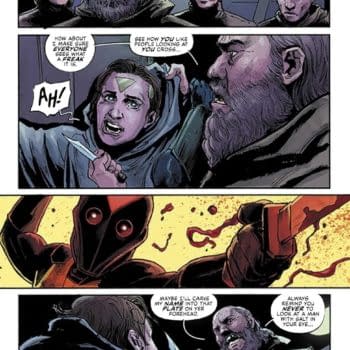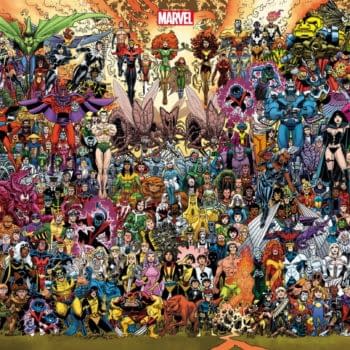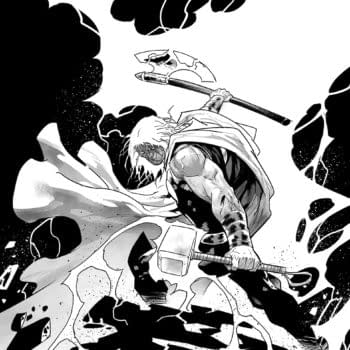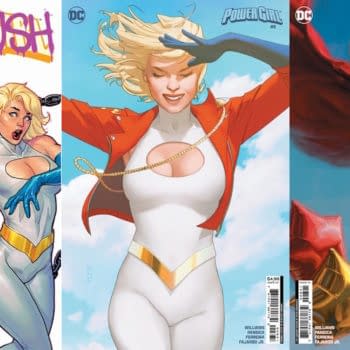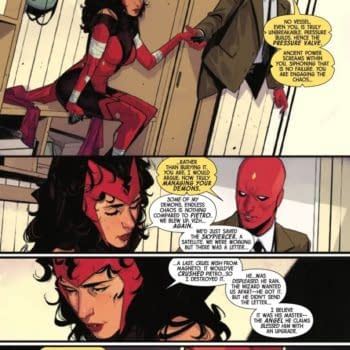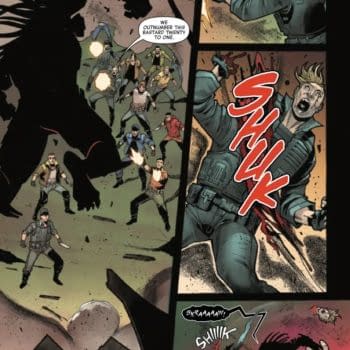Posted in: Comics | Tagged: Comics, entertainment
Reading Frostbite, Descender, Vikings: Uprising, and The Skeptics
If, like me, you often fall behind in your weekly comics reading and end up carving out time to suddenly read several issues at once (which can be really satisfying also), you know how unusual it is to *actually* read your weekly comics right away. This week's comics had that extra quality of urgency that made me not only read them the day I bought them, but want to write about them. They are Frostbite #2 from Vertigo, Descender #16 from Image, Vikings: Uprising #2 from Titan Comics, and The Skeptics #1 from Black Mask Studios.
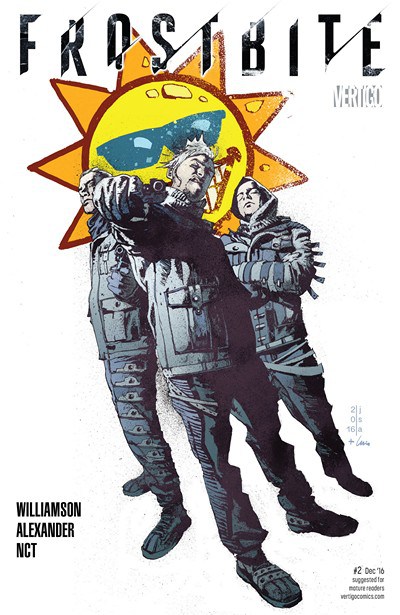 Frostbite is written by one of my longtime favorite writers, Joshua Williamson, and illustrated by an artist I've also followed for a long time, Jason Shawn Alexander, with really deft and evocative colors by Luis NCT. Fortunately, I'm not the only one who has noticed what a great team this is, since the first issue of the comic got rave reviews. The world of Frostbite is post modern ice-age, and focuses on the West Coast. In the complicated social structures that exist within a world struggling to survive polar cold, we follow a team of transporters for hire, a scientist who may be part of a cure to a new plague, and the underworld elements trying to hunt them down. This second issue continues with a nicely decompressed structure, spending plenty of time on the sheer difficulty of finding a transport out of LA, the dangers that buying contraband transport can evoke, and the everyday life of living in a place where heat is an expensive commodity. We also learn some more secrets about Keaton which make her an even more compelling character.
Frostbite is written by one of my longtime favorite writers, Joshua Williamson, and illustrated by an artist I've also followed for a long time, Jason Shawn Alexander, with really deft and evocative colors by Luis NCT. Fortunately, I'm not the only one who has noticed what a great team this is, since the first issue of the comic got rave reviews. The world of Frostbite is post modern ice-age, and focuses on the West Coast. In the complicated social structures that exist within a world struggling to survive polar cold, we follow a team of transporters for hire, a scientist who may be part of a cure to a new plague, and the underworld elements trying to hunt them down. This second issue continues with a nicely decompressed structure, spending plenty of time on the sheer difficulty of finding a transport out of LA, the dangers that buying contraband transport can evoke, and the everyday life of living in a place where heat is an expensive commodity. We also learn some more secrets about Keaton which make her an even more compelling character.
One of the remarkable things about Frostbite so far is the way in which the creators pare down and choose their moments. This is a busy comic, but not at all an overcrowded comic. It feels like each chosen moment is explored fully, not just presented as a stepping stone in the plot. The writer, artist, and colorist all contribute to this mood. No doubt Williamson is starting by choosing these intense emotional or confrontational moment, Alexander is unpacking them into the number of panels he feels appropriate to give each beat the right weight, and Luis is seems to speed things up and slow things down depending on his color choices. I didn't notice a single panel that was out of step with the very controlled pacing of the story, which is a pretty rare thing. No one expects comics to be perfect, but this one comes very close!
Descender is also a comic that has been universally praised, causing near-hysteria when it was originally announced because of the all-star team up of Jeff Lemire and Dustin Nguyen. Sixteen issues in, this is one of the longer runs of comics I've managed to stay with in recent days (Saga is another). Descender is a space opera set in both gentle and punchy watercolor by Nguyen, focusing on unlikely characters in a fairly wide cast, including a child robot, his robot dog, his grown up childhood companion, various other robots, the scientist who created them, and more. The universe they inhabit has been ravaged by a robot uprising with a mysterious origin and a robot holocaust which followed. What I noticed about issue #15 and now see again in issue #16 is a great deal of solid planning from Lemire and Nguyen.
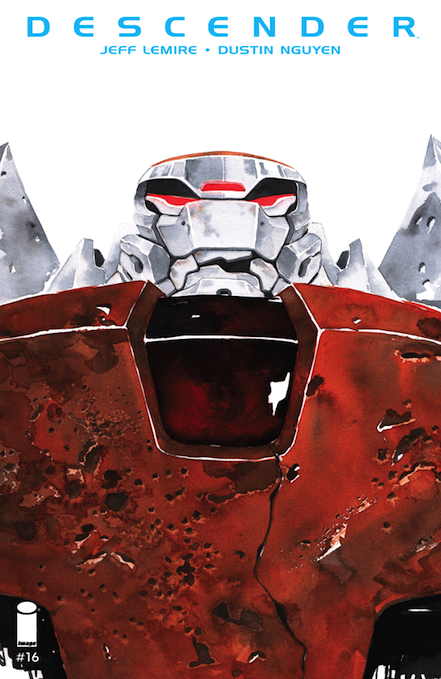 Issue #15 tells us a very emotional backstory about two of the human (well, once human?) characters, a teen love story, that is so neatly encapsulated in a single issue that you are reminded again of how Descender manages to push your empathy buttons for these characters. I kind of figured that issue was a one-off in this objective, but then we have issue #16, which focuses entirely, and for the first time entirely, on a particular robot's history. And he's been one of the biggest mysteries of the comic since its opening pages: Driller. A robot of few words, Driller has always seemed oddly anti-social, but we have kind of assumed bad experiences have made him that way. Now we learn that his story is much bigger, and deeper, than we might have imagined. If the creators are thinking "how can we reset this relationship with our readers and make sure they are still as engaged as possible in this comic?" then issues #15 and #16 have been a skillful response to that question. Descender proves that long-running stories can feel like a brand new experience each issue. That is no small feat. Descender is also lettered and designed by Steve Wands.
Issue #15 tells us a very emotional backstory about two of the human (well, once human?) characters, a teen love story, that is so neatly encapsulated in a single issue that you are reminded again of how Descender manages to push your empathy buttons for these characters. I kind of figured that issue was a one-off in this objective, but then we have issue #16, which focuses entirely, and for the first time entirely, on a particular robot's history. And he's been one of the biggest mysteries of the comic since its opening pages: Driller. A robot of few words, Driller has always seemed oddly anti-social, but we have kind of assumed bad experiences have made him that way. Now we learn that his story is much bigger, and deeper, than we might have imagined. If the creators are thinking "how can we reset this relationship with our readers and make sure they are still as engaged as possible in this comic?" then issues #15 and #16 have been a skillful response to that question. Descender proves that long-running stories can feel like a brand new experience each issue. That is no small feat. Descender is also lettered and designed by Steve Wands.
I don't actually know anyone else personally who reads the licensed Vikings comic, published by Titan, which spins out of the popular History Channel drama. But I've been amazed over the past couple of years what a wide fandom the show has. I initially thought I was just the geeky medieval scholar obsessed with the show until I started turning up to panels at comic conventions and seeing the extreme love for the show from hoards of fans. I started reading the comic in its first arc, Godhead, and returned for this new arc, called Uprising. The comic presents characters we know and love for the show, which is itself based on a viking saga, so story is really at the heart of this property. The events of the comic are set just after the previous season of the show, which returns to cable in less than a month. In other words, the timing is perfect to read this comic before the new season. The previous season jumped forward over a decade in time just before its finale, and that time period, unwritten for fans, is optimum storytelling time for comics.
 But I am a little hard on licensed comics–they have to be pretty high quality to keep me buying them. I won't pick them up them simply because I'm a fan of the given property. Having Cavan Scott as writer (whose work I have liked in the past) and Daniel Indro as artist (likewise) were a good draw on this series for me. They seem to be actually improving on this comic as they go, more fully filling out the visual world of the story and the nuances of the characters. This issue, #2, follows a new mystery in the attack on and destruction of the sacred temple of Uppsala, and the stand-out feature of this issue is the stunning artwork. It just gets better and better. Johnson is faithful to likenesses of known characters, but he's become increasingly confident in rendering details of viking life like clothing, and really adding depth to action scenes. I found myself wondering how the hell he knew how to choreograph certain fight panels, which were interacting with an outdoor town environment. This isn't boxing, but viking street fighting–and Johnson had to invent the instinctual physical reactions of his combatants. The result is not only believable but impressive. Kevin Enhart's color palette seems intuitively balanced to evoke a medieval world, and only touched by myth as well. The mood of comic established by his color choices is definitely something that keeps me coming back, too.
But I am a little hard on licensed comics–they have to be pretty high quality to keep me buying them. I won't pick them up them simply because I'm a fan of the given property. Having Cavan Scott as writer (whose work I have liked in the past) and Daniel Indro as artist (likewise) were a good draw on this series for me. They seem to be actually improving on this comic as they go, more fully filling out the visual world of the story and the nuances of the characters. This issue, #2, follows a new mystery in the attack on and destruction of the sacred temple of Uppsala, and the stand-out feature of this issue is the stunning artwork. It just gets better and better. Johnson is faithful to likenesses of known characters, but he's become increasingly confident in rendering details of viking life like clothing, and really adding depth to action scenes. I found myself wondering how the hell he knew how to choreograph certain fight panels, which were interacting with an outdoor town environment. This isn't boxing, but viking street fighting–and Johnson had to invent the instinctual physical reactions of his combatants. The result is not only believable but impressive. Kevin Enhart's color palette seems intuitively balanced to evoke a medieval world, and only touched by myth as well. The mood of comic established by his color choices is definitely something that keeps me coming back, too.
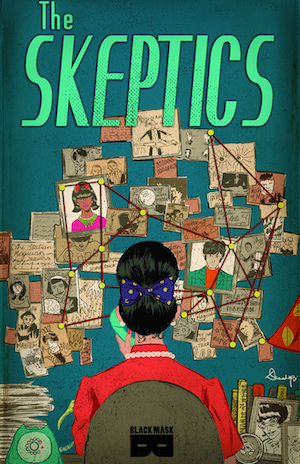 Saving an ambitious newcomer for the finale, I checked out the first issue of Black Mask Studios' new offering, The Skeptics, written by Tini Howard, and drawn by Devaki Neogi, with colors by Jen Hickman. I first heard about the comic at the Black Mask panel at New York Comic Con, and heard Howard speak very eloquently about the difficulties of writing a comic set in 1960's Washington DC featuring an African American female scientist lead with a Caucasian British love interest. There were a wealth of social conflicts to step through, rather than around, and Howard hit them head on rather than avoiding them. She found restaurants where mixed race couples could have actually met during that period, and devised a way of speaking and acting for Mary that would show her awareness of the limiting behavior of others and also entertaining ways for her to react–she's used to being "underestimated".
Saving an ambitious newcomer for the finale, I checked out the first issue of Black Mask Studios' new offering, The Skeptics, written by Tini Howard, and drawn by Devaki Neogi, with colors by Jen Hickman. I first heard about the comic at the Black Mask panel at New York Comic Con, and heard Howard speak very eloquently about the difficulties of writing a comic set in 1960's Washington DC featuring an African American female scientist lead with a Caucasian British love interest. There were a wealth of social conflicts to step through, rather than around, and Howard hit them head on rather than avoiding them. She found restaurants where mixed race couples could have actually met during that period, and devised a way of speaking and acting for Mary that would show her awareness of the limiting behavior of others and also entertaining ways for her to react–she's used to being "underestimated".
The story so far features Mary, Maxwell, and their professor Dr. Santaclara (a Latina professor during this period, and even just a female professor, is another lightning-rod for the world of the comic). Mary and Maxwell are being studied as possible psychic warriors for governmental use, spurred by fear that the soviets have two agents of their own during this Cold War period. Are their psychic abilities real or a front? The same goes for their Cold War counterparts. But this first issue is also about establishing these characters–their sense of self, sense of adventure, and their gumption, really.
The artwork by both Neogi and Hickman is designed to give a retro feel to the comic, one which is very successful. It conjures up spy posters from period films, early Scooby Doo cartoons, ads from the 60's, the works. Neogi's crisp inking really sets the tone, and Hickman's colors cement the illusion not just of life during the 60's but illustrated presentations of life in the 60's. These characters are cute, funny, ironic, underdogs in a less than forgiving world. I'm definitely on board for the next issue, and most likely for the whole series.
Those are some of the comics that really caught my attention this week, and I wanted to share the love, especially from these comics that continue to challenge the medium and introduce great artwork to new and ongoing readers.






